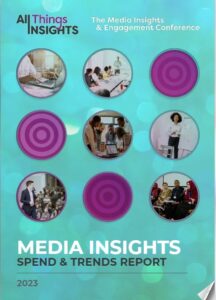Can’t Fight That Feeling (of Your Customers)
To effectively convert a consumer’s passion into a purchase, marketers must understand and leverage the emotional drivers behind buying decisions. By tapping into these emotions, brands can create compelling experiences that resonate with consumers on a deeper level, fostering connections and driving sales. That takes market research.
Emotional marketing is about understanding consumers backed by behavioral data, and tapping into a deeper level of awareness of their purchase drivers. This entails identifying the core emotions that your brand strives to convey, crafting an emotional narrative, and creating emotional triggers. Ultimately, this can be measured and refined by monitoring sales, website traffic, social media engagement, and customer feedback to assess the effectiveness of your emotional messaging.
So just what is emotional marketing? As Noble Studios notes, “When emotional marketing works, you don’t just know it – you feel it. The KPIs are measured in goosebumps, tears and skipped heartbeats: physical reactions caused by a sudden connection between brand and consumer.”
In its blog, “Guide to Emotional Marketing: Unleashing the Feels,” Noble Studios details the brand strategizing, researching, and testing that goes into creating an emotional connection with the consumer. Analytics that can be leveraged include:
- Primary Research: Gathering direct feedback from customers through surveys and interviews can provide valuable insights into their emotional connection with a brand. Asking specific questions about their emotional responses, brand perception and satisfaction levels can help gauge emotional engagement.
- Sentiment Analysis: Brands can learn a lot with social listening and sentiment analysis. Monitoring social media and analyzing the emotional tone of online content, language, discussions and context provides real-time understanding of consumers’ emotional needs and reactions.
- Brand Health Metrics: Tracking overall brand health takes into consideration metrics including brand awareness, brand perception and brand sentiment, but also metrics like brand affinity and brand recall. Taken together, these can provide valuable indicators and a comprehensive view of emotional engagement with a brand.
- Customer Loyalty Metrics: Evaluating customer loyalty metrics, such as customer retention rates, repeat purchase behavior and customer advocacy, can reflect the level of emotional engagement customers have with a brand.
- A/B Testing: A/B testing marketing assets that utilize different emotional appeals can produce data on which emotional levers resonate best with a particular audience. Brands can test ad creative, email subject lines, social content and more to see which emotional approach generates higher engagement and conversion rates.
- Behavioral Data: Analyzing customer behavior data, such as browsing patterns, purchase history and campaign engagement, provides insights into customers’ emotional responses. Identifying trends and patterns in customer interactions reveals levels of emotional engagement and impact on actions.
- Customer Lifetime Value (CLV): Customer lifetime value measures the financial value a customer brings to a brand over their entire relationship. Higher CLV indicates a stronger emotional connection, as emotionally engaged customers tend to have longer and more valuable relationships with a brand.
- Emotional Response Studies: Conducting controlled studies and experiments to measure emotional responses can provide valuable insights into the effectiveness of emotional marketing strategies. By monitoring physiological responses, facial expressions and self-reported emotions, brands can gauge the emotional impact of their campaigns.
Driving Emotional Understanding
During TMRE 2025, Seth Davis, CEO at Stern Pinball, will present the session, “High Score Strategy: Converting Passion to Purchase Through Emotional Understanding of Pinball Enthusiasts.”
Stern Pinball set out to understand what drives enthusiasts to make the significant leap from casual player to home machine owner. Deep, behavioral-science based interviews uncovered the profound emotional barriers and motivational triggers that influence this transformative journey. Davis will reveal how deep human truth can reveal how identity, community belonging, and affirmation shape purchase decisions, and how this helped the Stern brand create a strategic framework to better connect with potential owners at critical emotional touchpoints.
Key takeaways: How deep emotional research uncovers purchase barriers that traditional market research, or an AI only approach, could miss; how to understand what elements of your brand experience are most emotionally resonant; how you can reimagine your brand’s customer journey to transform brand enthusiasm into loyalty.
Closer to the Heart with Emotional Connections
More emotional marketing messages are not without some risk. Overexposure or potentially, if inadvertently, offending a culture or group can occur. Understanding your consumer is key.
Balancing emotion with some logic is also important. Noble Studios advises, “While emotional marketing aims to evoke emotions, balancing emotion with logic is essential. Emotional appeals need to be supported by rational arguments and information to build trust and credibility. Remember, your emotional connection is really there to support your primary selling point.”
Ultimately, leveraging sound research and analytics can help pinpoint just what is emotionally resonant with your audience. Noble Studio points out, “Strategies like personalization, social impact initiatives and customer-centric messaging help build emotional bonds. The key is authenticity. When brands speak from the heart, with actions to match their words, they can appeal to people’s sense of self, sense of place and sense of tribe. This means tapping into motivating feelings: inspiration, happiness and togetherness.”
Video: “What is Emotional Branding and How to Use it Effectively,” courtesy of Neighbourhood Company.
Contributor
-

Matthew Kramer is the Digital Editor for All Things Insights & All Things Innovation. He has over 20 years of experience working in publishing and media companies, on a variety of business-to-business publications, websites and trade shows.
View all posts





































































































































